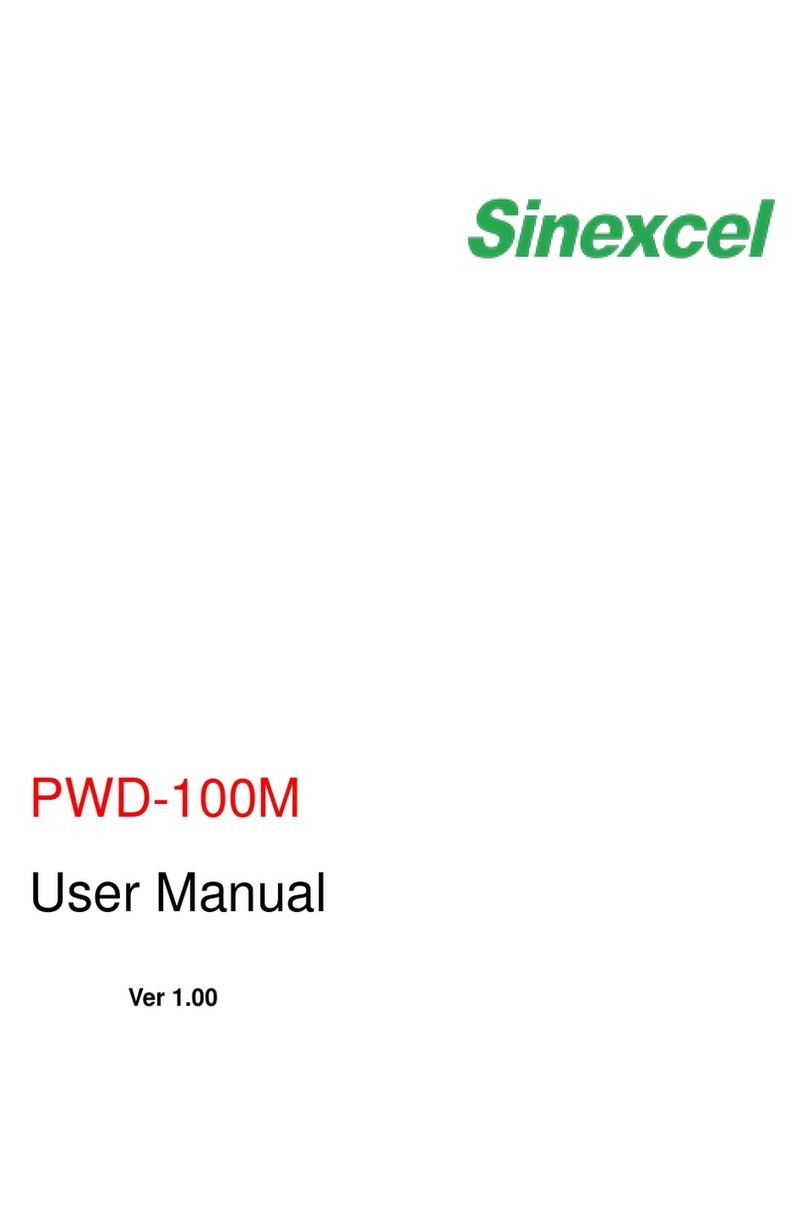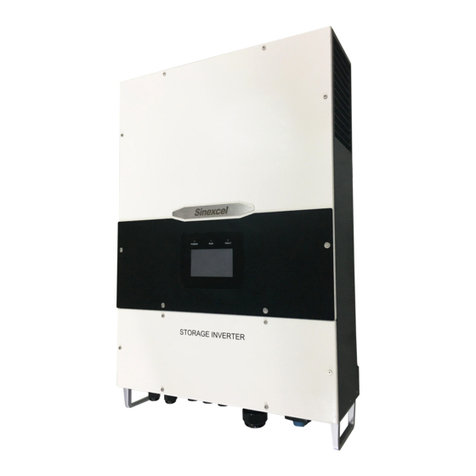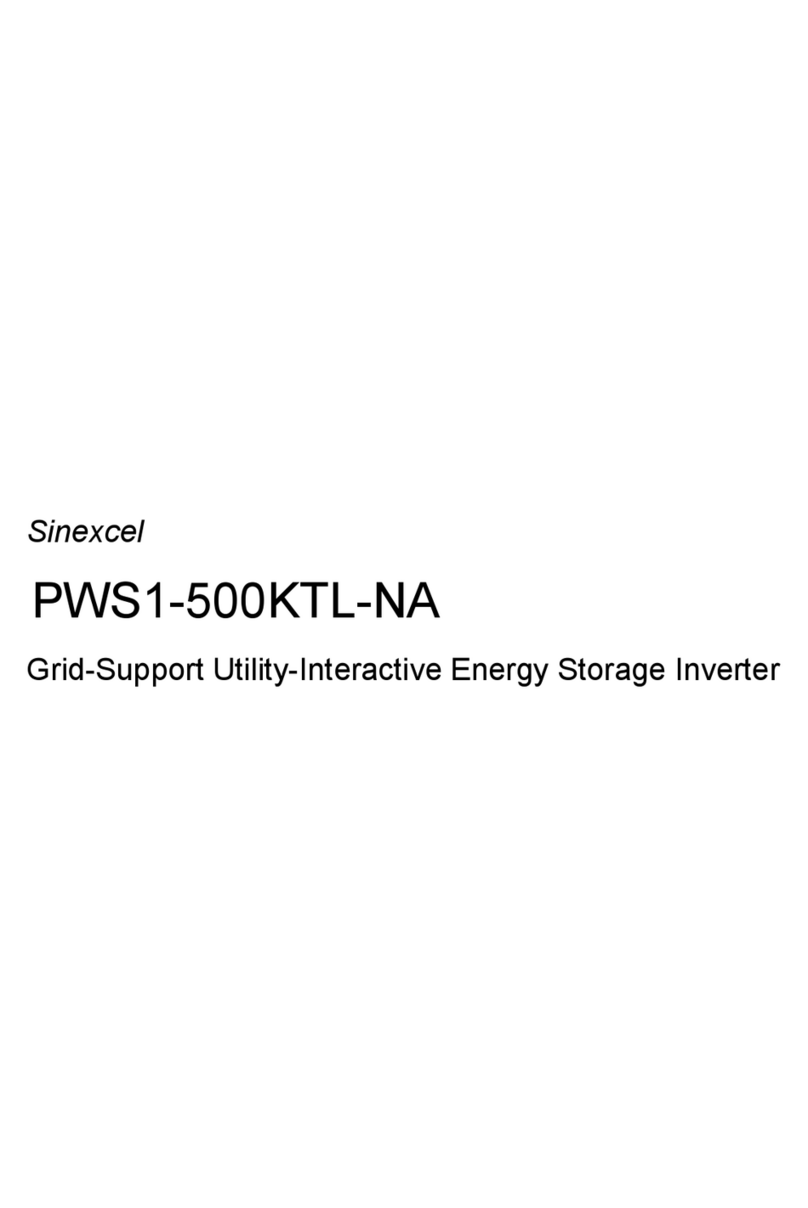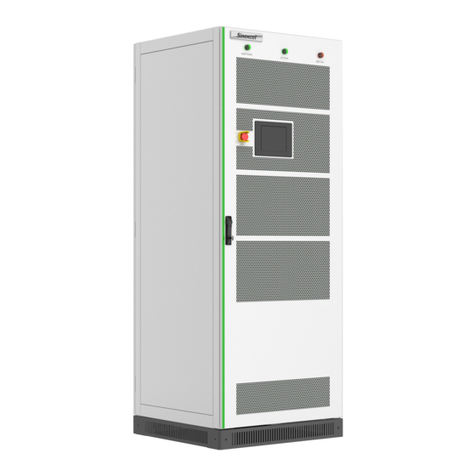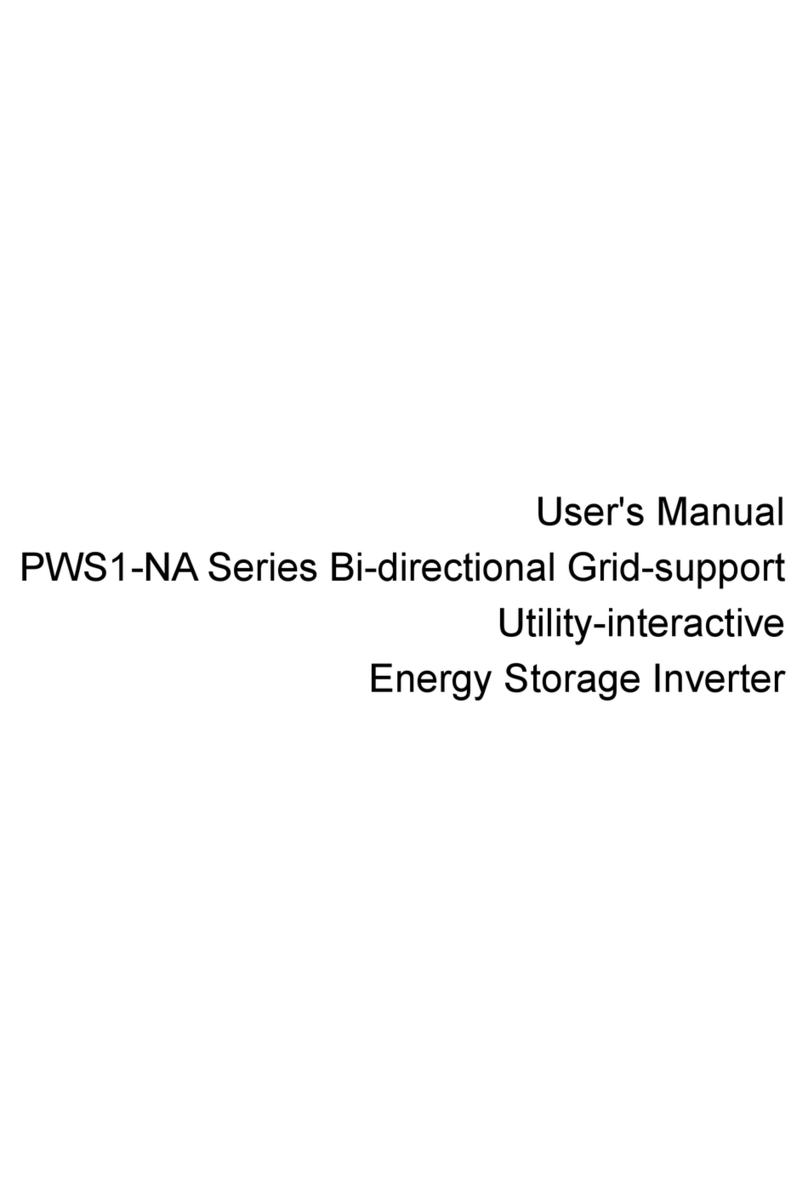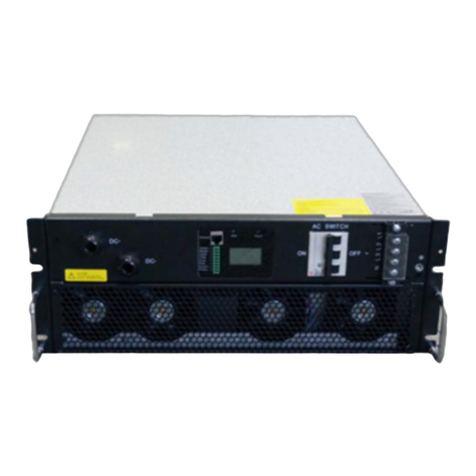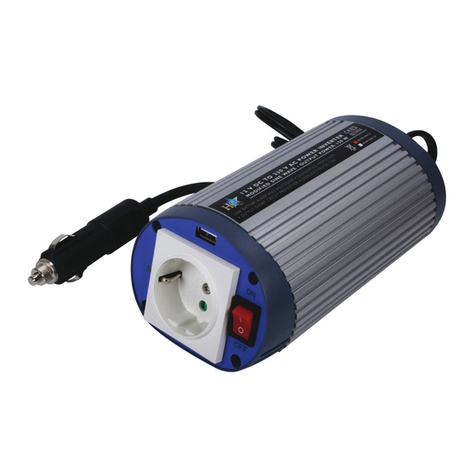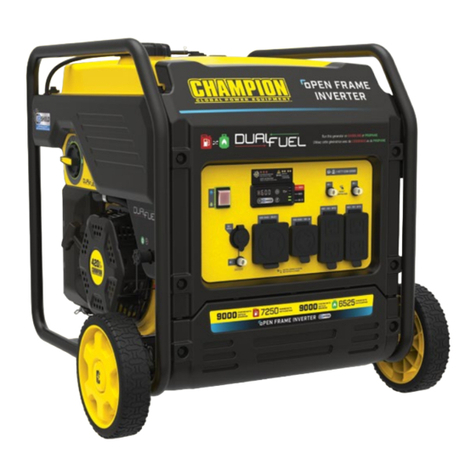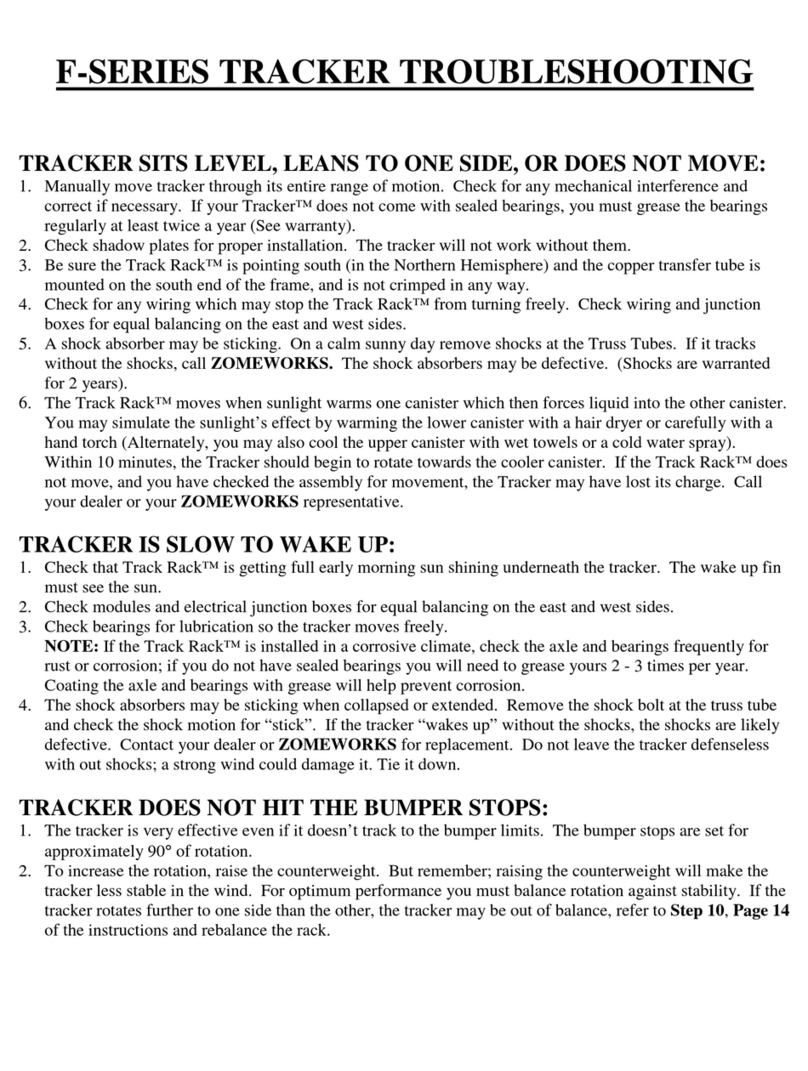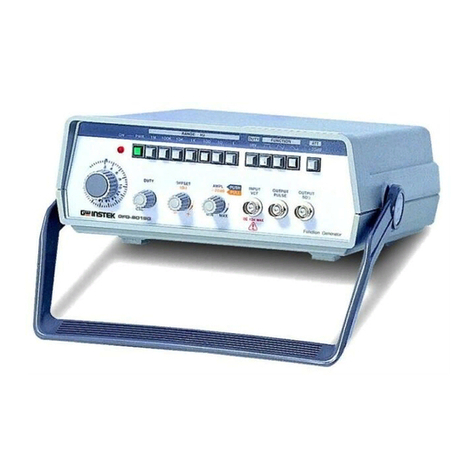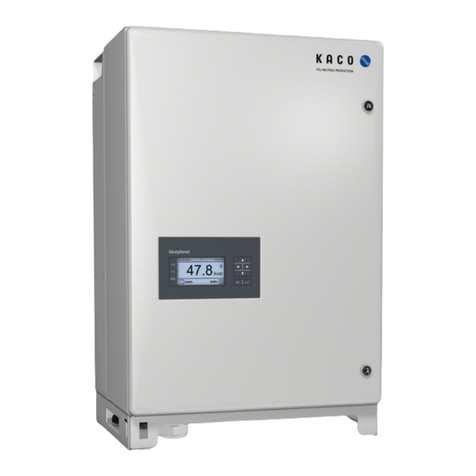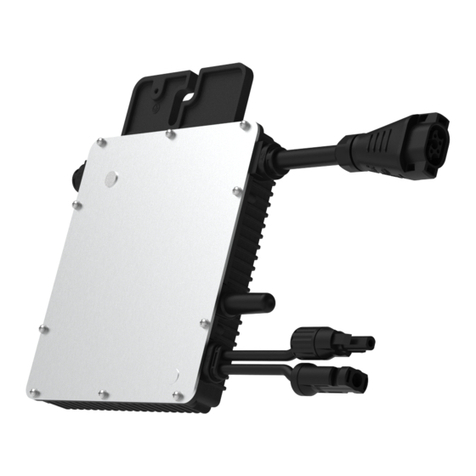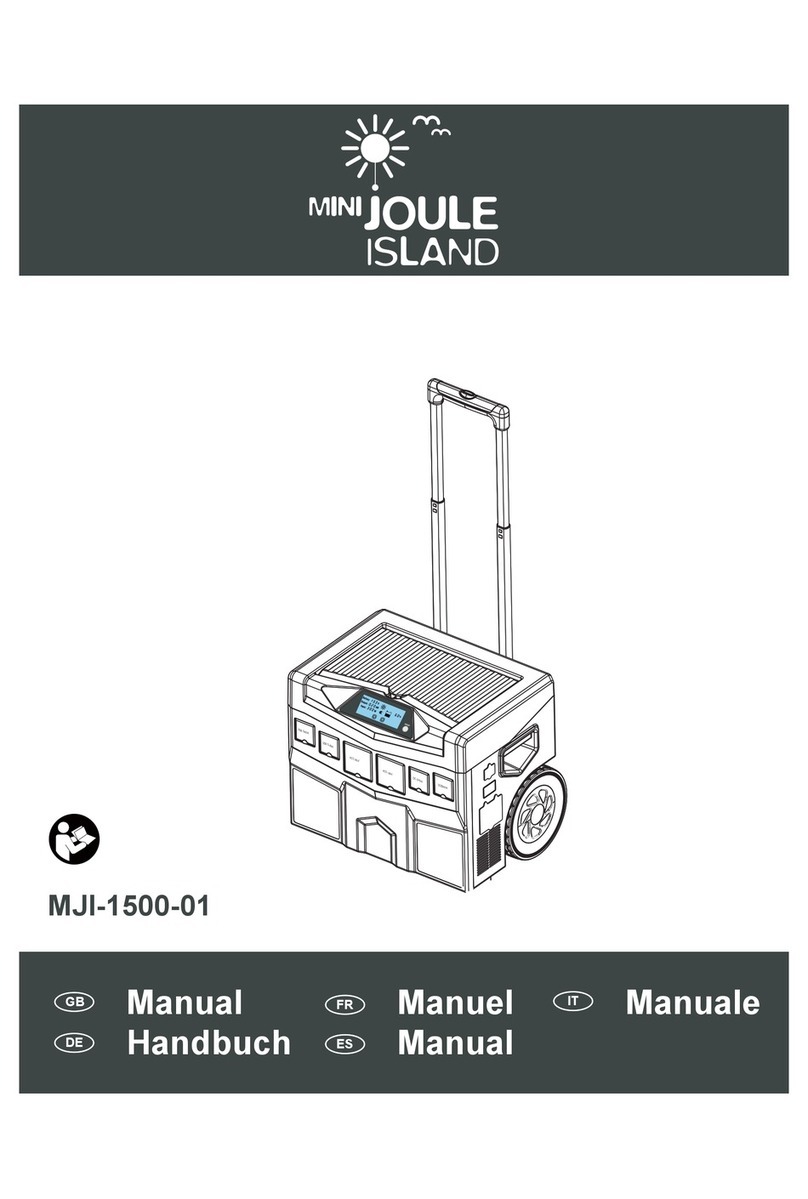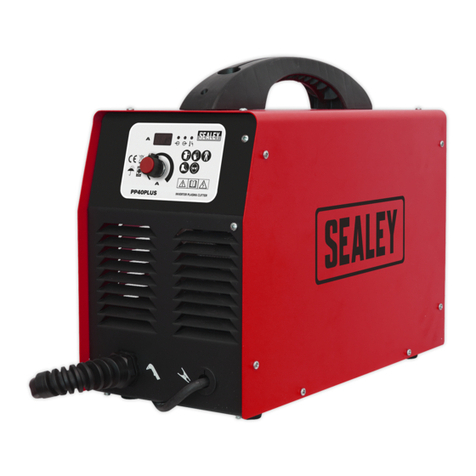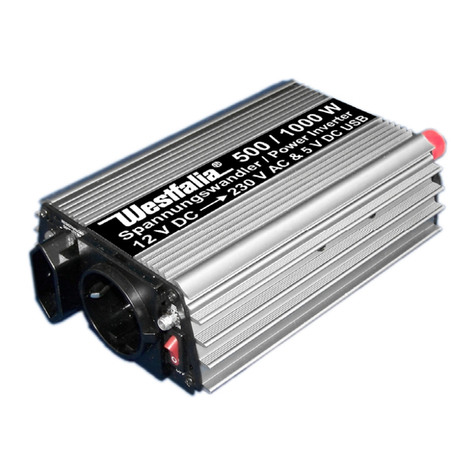Sinexcel PWS1-500K Series User manual

Operating Manual
PWS1-500K Series Energy Storage PCS

1
Sinexcel
PWS1-500KTL-EX-1M/2M/3M/4M/5M/6M/7M/8M
PWS1-500KTL-EX-M1/M2/M3/M4/M5/M6/M7/M8
Series Bi-direc ional Energy S orage PCS
Opera ing Manual
Version: V2.1
Shen hen Sinexcel Electric Co., Ltd.
All rights reserved. In case of any content change, it shall be without prior notice.
Shen hen Sinexcel Electric Co., Ltd.
Website: http://sinexcel.us/ or www.sinexcel.com
Add: Building 6, Area 2, Baiwangxin High-tech Industrial Park, No. 1002, Songbai Road, Nanshan District,
Shen hen
Postcode: 518055
Hotline: +86 0755-8651-1588

2
Table of Con en s
1 Information on this Document.................................................................................................................... 4
1.1 Validity ............................................................................................................................................... 4
1.2 Target Group ...................................................................................................................................... 4
1.3 Nomenclature Terms and abbreviations ................................................................................................ 5
2 Safety Precautions ..................................................................................................................................... 6
2.1 Symbols ............................................................................................................................................. 6
2.2 Important Safety instructions ............................................................................................................... 7
2.3 Additional Information ......................................................................................................................... 8
3 Product Introduction.................................................................................................................................. 9
3.1 System Introduction ............................................................................................................................ 9
3.2 PCS Appearance ................................................................................................................................. 9
3.3 System Schematic Diagram ................................................................................................................. 9
3.4 PCS Composition ............................................................................................................................... 11
3.5 Operating Compositions .................................................................................................................... 12
3.5.1 Switches Introduction ................................................................................................................. 12
3.5.2 Touch Screen ............................................................................................................................. 13
3.5.3 LEDs of the System .................................................................................................................... 14
3.5.4 Labels ........................................................................................................................................ 15
4 Technical Data ........................................................................................................................................ 17
5 Storing, lifting and transporting ................................................................................................................ 23
5.1 Safety during Transport ..................................................................................................................... 23
5.2 Transporting the PCS ......................................................................................................................... 23
5.2.1 Transport and storage ................................................................................................................. 23
5.3 Unpacking the PCS ............................................................................................................................ 23
6 Installation ............................................................................................................................................. 24
6.1 Safety during Installation ................................................................................................................... 24
6.2 Mechanical Installation ...................................................................................................................... 25
6.2.1 Mounting preparation .................................................................................................................. 25
6.2.2 Preparation for Mounting on a Base ............................................................................................. 26
6.3 Electrical Connections ....................................................................................................................... 26
6.3.1 Input requirement ...................................................................................................................... 26
6.3.2 Output requirement .................................................................................................................... 27
6.3.3 Wiring mode .............................................................................................................................. 27
6.3.4 System grounding ....................................................................................................................... 34
6.3.5 DC port wiring ............................................................................................................................ 34
6.3.6 AC port wiring ............................................................................................................................ 35
6.3.7 Wiring of terminal strips .............................................................................................................. 35
6.4 Communication interface connection .................................................................................................. 38
6.4.1 Connecting the EMS over RS485 or Ethernet ................................................................................ 38
6.4.2 Connecting a BMS over CAN ........................................................................................................ 39
6.5 Check after installation ...................................................................................................................... 40
7 Function Description ................................................................................................................................ 41
7.1 Operating Status ............................................................................................................................... 41
7.1.1 Overview of the Operating Status ................................................................................................ 41
7.1.2 Operating States without STS ...................................................................................................... 42
8 Operation ............................................................................................................................................... 43
8.1 Safety during Operation .................................................................................................................... 43
8.2 Power On Procedure ......................................................................................................................... 43

3
8.3 Setting Procedure before startup ....................................................................................................... 44
8.3.1 Touch screen power on ............................................................................................................... 44
8.3.2 Log into the control Interface ...................................................................................................... 45
8.3.3 Select Control Mode .................................................................................................................... 45
8.3.4 General Settings ......................................................................................................................... 46
8.3.5 Communication setting ............................................................................................................... 46
8.4 Manual Startup Procedure ................................................................................................................. 46
8.5 Automatic Startup Procedure ............................................................................................................. 47
8.6 Remote Startup Procedure ................................................................................................................. 47
8.7 Shutdown Procedure ......................................................................................................................... 47
8.8 System Power Off ............................................................................................................................. 47
8.9 Emergency shutdown ........................................................................................................................ 47
9 Troubleshooting ...................................................................................................................................... 48
9.1 Safety during Troubleshooting ........................................................................................................... 48
9.2 Export fault record ............................................................................................................................ 48
9.3 Faults caused by improper parameter settings .................................................................................... 48
9.4 Detailed Troubleshooting ................................................................................................................... 49
10 Maintenance ......................................................................................................................................... 50
10.1 Safety during Maintenance .............................................................................................................. 50
10.2 Maintenance Schedule and Consumables .......................................................................................... 50
10.2.1 Operation environment requirements ......................................................................................... 50
10.2.2 Electrical and fixed connection inspection ................................................................................... 51
10.2.3 Clearing and cleaning ................................................................................................................ 51
10.3 Maintenance Work .......................................................................................................................... 51
11 Contact ................................................................................................................................................. 52
Appendix 1 Settings on HMI (Touch Screen) ................................................................................................ 53
12.1 Touch Screen Startup ...................................................................................................................... 53
12.1.1 Main Menu Structure before log-in ............................................................................................. 53
12.1.2 Log into the control Interface .................................................................................................... 54
12.2 Main Menu Structure after log-in.................................................................................................... 55
12.3 Control Mode Setting ....................................................................................................................... 56
12.4 Parameter Setting ........................................................................................................................... 56
12.4.1 Settings Menu .......................................................................................................................... 56
12.5 Common Setting ............................................................................................................................. 62
12.5.1 Language Selecting ................................................................................................................... 62
12.5.2 Date and Time Selecting ........................................................................................................... 62
12.5.3 Communication setting .............................................................................................................. 62
12.5.4 AC settings ............................................................................................................................... 62
12.5.5 DC settings ............................................................................................................................... 64
12.5.6 Regulating the reactive power of the ESS AC port in on-grid mode .............................................. 65
12.6 System Setting ................................................................................................................................ 66
12.6.1 General Setting ......................................................................................................................... 67
12.7 Manual Startup ............................................................................................................................... 67
12.8 Automatic startup ........................................................................................................................... 68
12.9 Remote startup ............................................................................................................................... 68
12.10 Shutdown procedure ..................................................................................................................... 68
12.11 System Power Off .......................................................................................................................... 69
12.12 Emergency shutdown .................................................................................................................... 69
Appendix 2 Limited Warranty Policy ............................................................................................................. 70

4
1 Informa ion on his Documen
1.1 Validi y
This document is valid for the following device models with or without STS module:
• PWS1-500K
• PWS1-500KTL
• PWS1-500KTL-EX-1M/2M/3M/4M/5M/6M/7M/8M
• PWS1-500KTL-EX-M1/M2/M3/M4/M5/M6/M7/M8
Model defini ion
This section introduces product model definition in this operating manual, as shown in Fig. 1-1:
PWS
1
-
500
KTL
-
EX
-
XM
Rated Power
:
500K
500KTL: 500K Transformerless
500K: 500K with transformer
Bi-directional Energy Storage PCS
EX: For Europ and other country
XM: Module number
MX
:
DC input number
Fig.1-1 Product model definition
For example:
PWS1-500KTL: 500kW Bi-directional storage inverter without isolation transformer.
PWS1-500K: 500kW Bi-directional storage inverter with isolation transformer.
Check the type label for the production version of PCS.
The illustrations in this document have been reduced to be necessary and may differ from the real product.
1.2 Targe Group
The tasks described in this document can only be performed by professionals or other qualified persons.
Qualified persons must have the following skills
:
• Understand how the product works and how to operate the product
• Understand how the battery works and how to operate the battery
• Training on how to deal with the ha ards and risks associated with installing and using electrical
equipment installation
• Installation and commissioning of electrical equipment and installations
• Understand all applicable standards and directives
• Understand and follow this manual and all safety information

5
1.3 Nomencla ure Terms and abbrevia ions
Terms Definition
STS Static Transfer Switch
AC Alternative current.
DC Direct current.
BESS Battery energy storage system
ESS Energy storage system.
EMS Energy management system.
BMS Battery management system.
PCS Power conversion system.
SLD Single line diagram
SOH State of health (of battery), expressed in percentage.
SCR Silicon controlled rectifier
DOD Depth of discharge, the rest battery capacity, expressed in percentage.
EOD End of discharging.
SOC State of charge (of battery).
UI User Interface
EPO Emergency Power Off
SPD Surge Protecting Device

6
2 Safe y Precau ions
2.1 Symbols
NO.
Symbol Reference Standard Description
1
IEC 60417-5036
IEC 60417-5416
Note the shock ha ard,
energy storage time
release (discharge time
is marked next to the
symbol)
2
ISO 7000-0434 Watch out for danger
3
IEC 60417-5041 Watch out for hot
surface
4
ISO 7000-1641
Refer to the operation
manual
Symbol
Explanation
Indicates a dangerous situation that, if not avoided, will result
in death or serious injury
Indicates a dangerous situation that, if not avoided, will result
in death or serious injury

7
Indicates a dangerous situation that, if not avoided, may result
in minor or moderate injury
Indicates that if property damage is not avoided
Draw attention to important information, best practices and tips
NOTE is used to address information that is not related to pers
onal injury, equipment damage, and environmental degradation.
2.2 Impor an Safe y ins ruc ions
This user’s manual is about installation and operation of Sinexcel PWS1 series 500kW Bi-directional Energy
Storage Inverter (PCS).
Before installation, please read this user’s manual carefully.
The PCS must be commissioned and maintained by the engineers designated by the manufacturer or the
authori ed service partner. Otherwise, it might endanger personal safety and result in device fault. Any
damage against the device caused thereby shall not be within the warranty scope.
The PCS cannot be used for any circumstance or application related to life support device.
This manual contains important instruction for Models of PWS1 series that shall be followed during
installation and maintenance of the PCS.
Any contact with copper bar, contactor and terminal inside the device or connected with the loop of utility
grid might result in burning or fatal electric shock.
Don’t touch any terminal and conductor connected with the loop of utility grid.
Pay attention to any instruction and safety documents about power on-grid.
There might be an electric shock risk inside the device!
Any operation related to this device will be conducted by professionals.
Pay attention to the safety precautions listed in safety instruction and installation documents.
Pay attention to the safety precautions listed in operating and installation manual and other documents.
Large leakage current
Before connecting input power supply, please ensure that the grounding is reliable.
The device must be grounded complying with the local electric codes.

8
When storage battery is connected to PCS, there may be DC voltage at input port. Please pay attention to it
during operation or check the battery system user manual
Don’t touch electric parts within 15 minutes after power outage!
There is dangerous energy in capacitance storage. Don’t touch device terminal, contactor and cooper bar
and other electric parts within 15 minutes after disconnecting all device power supplies.
All maintenance and preservation inside the device require using tools and shall be conducted by trained
person. The components behind the protective cover plate and dam board which are opened by tools cannot
be maintained by users.
Please read this user’s manual before operation.
2.3 Addi ional Informa ion
Links to additional information can be found at http://sinexcel.us/ or www.sinexcel.com.

9
3 Produc In roduc ion
3.1 Sys em In roduc ion
The [PWS1-500K series Bi-directional Storage Inverter (PCS)] is a battery power conversion system that
converts the DC (direct current) supplied by a battery into grid-compliant AC (alternating current). An
[external] low voltage transformer fitted downstream feeds the AC (alternating current) into the utility grid.
This kind of PCS can be used in the on-grid mode and off-grid mode. The model with STS can get the faster
switching between on-grid and off-grid mode.
The [PWS1-500K series Bi-directional Storage Inverter (PCS)] can be used in off-grid systems based on
diesel generators (Gensets).
3.2 PCS Appearance
3
1
2
Figure3- 1: Design of the PCS
Position
Designat
ion
1 Indicator light
2 HMI(Touch Screen)
3 EPO (Emergency Power Off)
3.3 Sys em Schema ic Diagram
PWS1-500K Bi-directional Storage Inverter (PCS) is composed of 8 PCS-AC modules. The modules identify
master-slave systems through the DIP switch dial-up codes on the panel. #1 is a master system, while other
modules track the master system. The Bi-directional Storage Inverter (PCS) cabinet is equipped with SPD
protector, AC/DC breaker and distribution units. If on/off-grid switching is to be achieved, extra power
distribution unit needs to be added. Fig.3-2 is a topological graph for its composition and structure.

10
L1
L2
L3
N
AC SwitchDC Switch 1
AC SPD
Battery
-
PCS-AC, n=1~8
·······
PCS-AC 1
PCS-AC n
Grid
Fig. 3-2 Topological graph for Bi-directional Storage Inverter (PCS) with 1 branch input
DC Switch n
Battery
-
DC Switch
1
Battery
-
L
1
L
2
L
3
…
…
PCS-AC, n=1~8
…
…
PCS-AC 1
PCS-AC n
AC Switch
AC SPD
Grid
DC Switch, n=1~8
Fig. 3-3 Topological graph for Bi-directional Storage Inverter (PCS) with 1/2/3/4/5/6/7/8 branch input
Both models have identical mechanical and electrical construction except composed of different sets of
PCS-AC modules and rating:
For PWS1-500K series is composed of 8 sets of PCS-AC modules, the special model with different number of
DC branch switches from 1 to 8.
Main composition of PWS1-500K PCS rack is shown in Table.3-2.
Table 3-2 Main composition of the PCS rack
Serial No. Item Quantity Remark
1 Cabinet set The cabinet is equipped with distribution

11
components.
2 PCS-AC module 8 set(s)
3 Power Management Unit 1 set It is installed in the cabinet door.
3.4 PCS Composi ion
3
1
2
5
4
10
7
8
9
6
5
4
10
7
8
9
6
Figure3-3: Visible Components of the PCS without STS module with STS module
Position Designation Description
1 Indicator lights
2 Touch Screen
3 EPO (Emergency Power Off)
4 PCS-AC (1~8 module(s)) 62.5KW 1 set
5 Battery DC Branch Switch 1 to 8 set DC Branch Switch
6 U2 Main control board
7 AC Switch
8 Wiring terminal
9 SPD switch
10 AUX Power supply switch
Components position 8 Wiring Terminal, 9 SPD switch, 10 AUX power supply switch can be seen after unfold
the dam-board.

12
3.5 Opera ing Composi ions
3.5.1 Swi ches In roduc ion
3.5.1.1 AC swi ch
The AC disconnection unit disconnects the PCS from the Grid. The NA series PCS breaker is comply to the UL
certification.
I
O
▽
▽▽
▽
Figure 3-4: Switch positions of the AC disconnection unit
Position Designation Explanation
I Switch position In (On) The AC disconnection unit is closed.
▽
Central switch position The AC disconnection unit was tripped and is open.
O Switch position off The AC disconnection unit is open.
3.5.1.2 DC Swi ch
The DC disconnection unit disconnects the PCS from the Battery module arrays. The NA series PCS breaker
is comply to the UL certification.
I
O
▽
▽▽
▽
Figure 3-5: Indicators on the DC load-break switch
Position Designation Explanation
I Switch position In (On) The DC disconnection unit is closed.
▽
Central switch position The DC disconnection unit was tripped and is open.
O Switch position off The DC disconnection unit is open.

13
3.5.1.3 AUX power supply AC Swi ch
220Vac AUX power supply can be the redundancy power supply through the AC Switch inside the PCS
cabinet. These switches can be visible after opening the dam-board.
AUX power supply switch
SPD switch
Figure 3-6: AUX power supply AC Switch and SPD switch
3.5.2 Touch Screen
3.5.2.1 User In erface
The touch display is used to display instantaneous values and parameter settings. Click the touch screen
with fingernail. Tapping the symbols on the touch display activates the corresponding functions. If the touch
display has not been touched for
【
ten
】
minutes, the display is locked and the logged-in user will be logged
out. By tapping the screen unlock the display again.
The touch display is divided into two areas.
A
B
C
Figure 3-7 UI Design of the touch display

14
Position Designation Explanation
A Menu Menu can be different before/after log-in and other setting.
B System Topology
C Version and time
3.5.2.2 Symbols Explana ion
Symbol Designation
Grid
Load in AC side
DC side
STS Module
Transformer (Inside)
AC
DC
AC Module
Switch on DC or AC side open
Switch on DC or AC side closed
3.5.3 LEDs of he Sys em
The appearance of the PCS is shown in below. Front door body is mainly composed of touch screen, normal indicator light,
alarm indicator light and emergency shutdown button etc.
5
3
4
2
1
Figure 3-8 LEDs on the front panel
LED designation Description Explanation
1 Fault indicator light
2 Normal indicator light
3 Power indicator light
4 Touch screen
5 Emergency shutdown button

15
1
2
4
5
7
6
3
Figure 3-9 Front view for PCS-AC module
LED designation Description Explanation
1 Normal indicator light Green
2 Fault indicator light Red
3 DIP switch Address
4 Hanger
5 Power supply socket
6 Communication cable socket
7 Handle Can’t bearing too much weight
3.5.4 Labels
Figure 3-11 Warning label position

16
No. Label Explanation
1
Label-Dot label-A phase
2
Label-Dot label-B phase
3
Label-Dot label-C phase
4
Label-Dot label-Negative electrode
5
Label-Dot label-Negative electrode
6
Label-Dot label-Negative electrode
7
Label-Dot label-Neutral line
8
Label-Dot label-Grounding
9
Label-Warning label-Danger High Voltage
10
Label-Warning label-Danger large leak current

17
4 Technical Da a
Technical parameters for the models without transformer (500KTL series)
Specification
Model
PWS1-
500KTL
-EX-8M
PWS1-
500KTL-
EX-7M
PWS1-
500KTL
-EX-6M
PWS1-
500KTL
-EX-5M
PWS1-
500KTL-
EX-4M
PWS1-
500KTL-
EX-3M
PWS1-
500KTL-
EX-2M
PWS1-
500KTL-
EX-1M
Utility-interactive Mode
Battery voltage
range 600~900V
Battery Normal
voltage 750V
DC max current 873A 763A 654A 545A 436A 327A 218A 109A
AC voltage 400Vac (3P3W)
AC current(rms) 720A 630A 540A 450A 360A 270A 180A 90A
AC max
current(rms) 792A 693A 594A 495A 396A 297A 198A 99A
Current(inrush) 72A 63A 54A 45A 36A 27A 18A 9A
Maximum output
fault current 1080A 945A 810A 675A 540A 405A 270A 135A
Maximum output
overcurrent
protection
1080A 945A 810A 675A 540A 405A 270A 135A
Nominal power 500kVA 437.5kVA 375kVA 312.5kVA 250kVA 187.5kVA 125kVA 62.5kVA
AC max power 550kVA 481.2kVA 412.5kVA 343.8kVA 275kVA 205.2kVA 137.5kVA 68.7kVA
AC frequency 50/60Hz(±2.5Hz)
THDi ≤3%
AC PF Listed: 0.8~1 leading or lagging (Controllable)
Actual: 0.1~1 leading or lagging (Controllable)
Stand-alone Mode
Battery voltage
range 600~900V
Battery Normal
voltage 750V
DC Max Current 873A 763A 654A 545A 436A 327A 218A 109A
AC voltage 400Vac (3P3W)
AC voltage range 360~440V
AC current(rms) 720A 630A 540A 450A 360A 270A 180A 90A
AC max 792A 693A 594A 495A 396A 297A 198A 99A

18
current(rms)
Current(inrush) 72A 63A 54A 45A 36A 27A 18A 9A
Maximum output
fault current 1080A 945A 810A 675A 540A 405A 270A 135A
Maximum output
overcurrent
protection
1080A 945A 810A 675A 540A 405A 270A 135A
Nominal power 500kVA 437.5kVA 375kVA 312.5kVA 250kVA 187.5kVA 125kVA 62.5Kva
AC max power 550kVA 481.2kVA 412.5kVA 343.8kVA 275kVA 205.2kVA 137.5kVA 68.7kVA
Output THDU
≤
2%
(
Linear load
)
AC frequency 50/60Hz
AC PF Listed: 0.8~1 leading or lagging (Load-depend)
Actual: 0.1~1 leading or lagging (Load-depend)
Overload
Capability
105%~115% 10min;
115%~125% 1min;
125%~150% 200ms
Physical
Cooling Forced air cooling
Noise 70dB
Enclosure IP20
Max elevation 3000m/10000feet (> 2000m/6500feet derating)
Operating ambient
temperature -20°C to 50°C (De-rating over 45°C
)
Humidity 0~95% (No condensing)
Size (W
×
H
×
D) 1100
×
2160
×
800mm
Weight 600Kg 550Kg 500Kg 450Kg 400Kg 350Kg 300Kg 250Kg
Installation Floor standing
Other
Peak efficiency 98.20%
Protection OTP, AC OVP/UVP, OFP/UFP, EPO, AC Phase Reverse, Fan/Relay Failure, OLP, GFDI, Anti-islanding
Storage type Lithium iron phosphate battery
Configurable
protection limits Upper/Lower AC Voltage/Frequency limit, Battery EOD voltage.
AC connection 3-Phase 3-Wire
Display Touch Screen
Communication RS485, CAN, Ethernet
Isolation Non-isolated
Active anti-islanding
method AFD (
Active Frequency Disturbance)

19
Over voltage
category III
Specification
Model
PWS1-
500KTL-
EX-M8
PWS1-
500KTL-
EX-M7
PWS1-
500KTL-
EX-M6
PWS1-
500KTL-
EX-M5
PWS1-
500KTL
-EX-M4
PWS1-
500KTL-
EX-M3
PWS1-
500KTL-
EX-M2
PWS1-
500KTL-
EX-M1
Utility-interactive Mode
Battery voltage
range 600~900V
Battery Normal
voltage 750V
DC max current 873A 763A 654A 545A 436A 327A 218A 109A
AC voltage 400Vac (3P3W)
AC current 720A 630A 540A 450A 360A 270A 180A 90A
AC max current 792A 693A 594A 495A 396A 297A 198A 99A
Current(inrush) 72A 63A 54A 45A 36A 27A 18A 9A
Maximum output
fault current 1080A 945A 810A 675A 540A 405A 270A 135A
Maximum output
overcurrent
protection
1080A 945A 810A 675A 540A 405A 270A 135A
Nominal power 500kVA 437.5kVA
375kVA 312.5kVA 250kVA 187.5kVA
125kVA 62.5kVA
AC max power 550kVA 481.2kVA
412.5kVA
343.8kVA 275kVA 205.2kVA
137.5kVA
68.7kVA
AC frequency 50/60Hz(±2.5Hz)
THDi ≤3%
AC PF Listed: 0.8~1 leading or lagging (Controllable)
Actual: 0.1~1 leading or lagging (Controllable)
Stand-alone Mode
Battery voltage
range 600~900V
Battery Normal
voltage 750V
DC Max Current 873A 763A 654A 545A 436A 327A 218A 109A
AC voltage 400Vac (3P3W)
AC voltage
range 360~440V
AC current(rms) 720A 630A 540A 450A 360A 270A 180A 90A
AC max
current(rms) 792A 693A 594A 495A 396A 297A 198A 99A
This manual suits for next models
16
Table of contents
Other Sinexcel Inverter manuals
Popular Inverter manuals by other brands
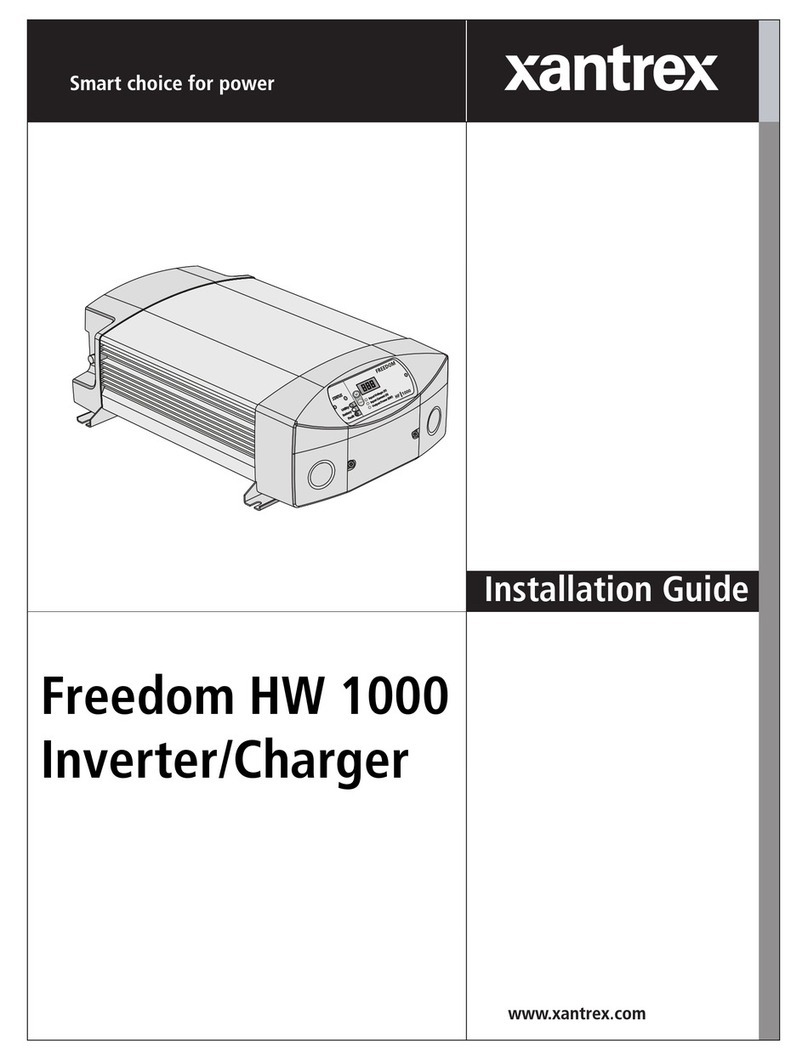
Xantrex
Xantrex FREEDOM HW 1000 installation guide
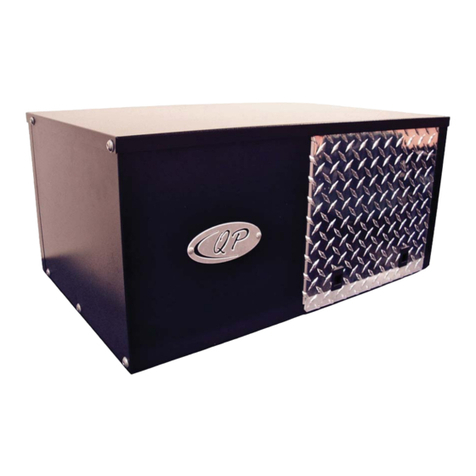
Generac Power Systems
Generac Power Systems 004709-0 owner's manual

SMA
SMA 8000TL Replacement manual
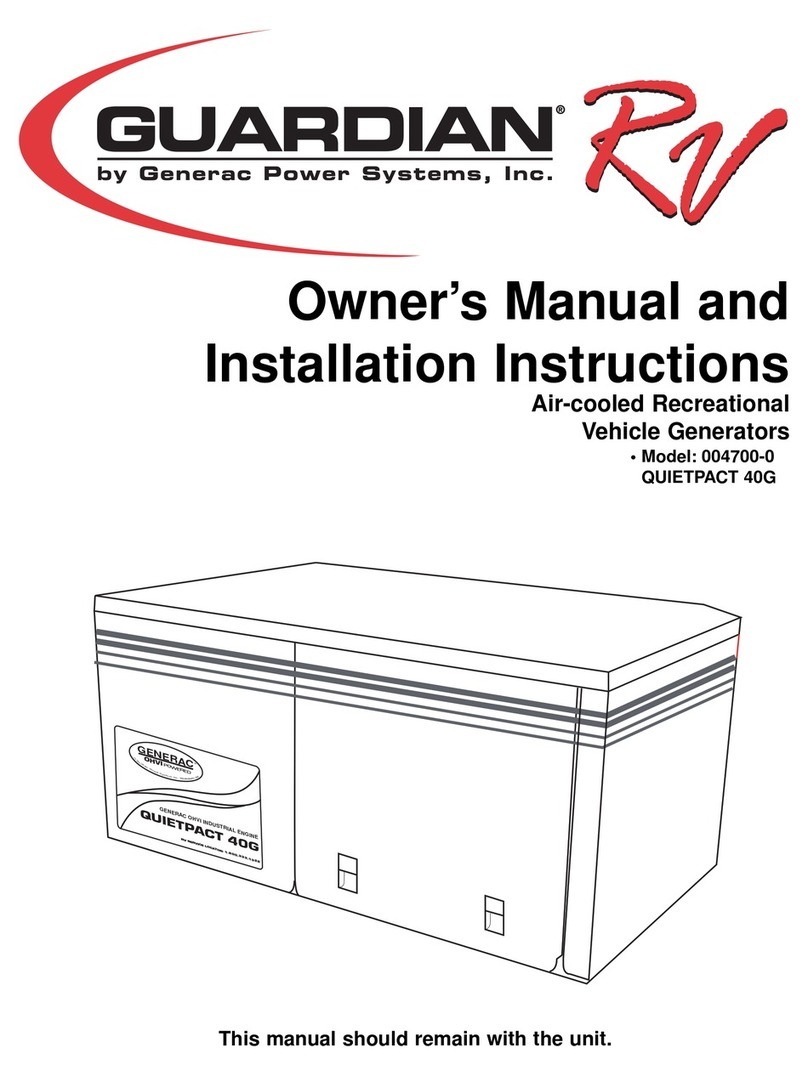
Generac Power Systems
Generac Power Systems 004700-0 Installation and owner's manual
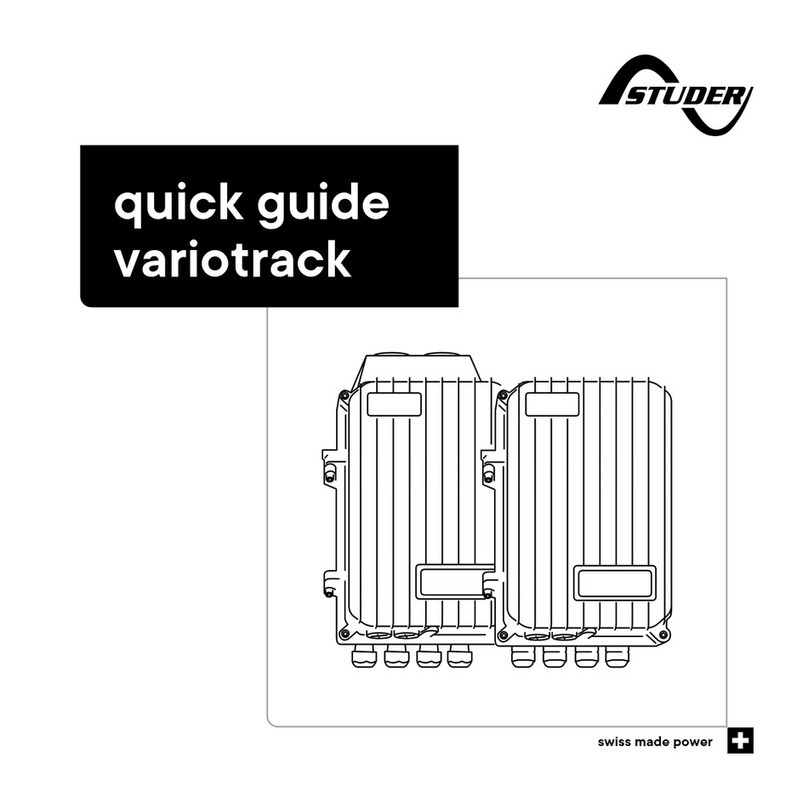
Studer
Studer variotrack quick guide
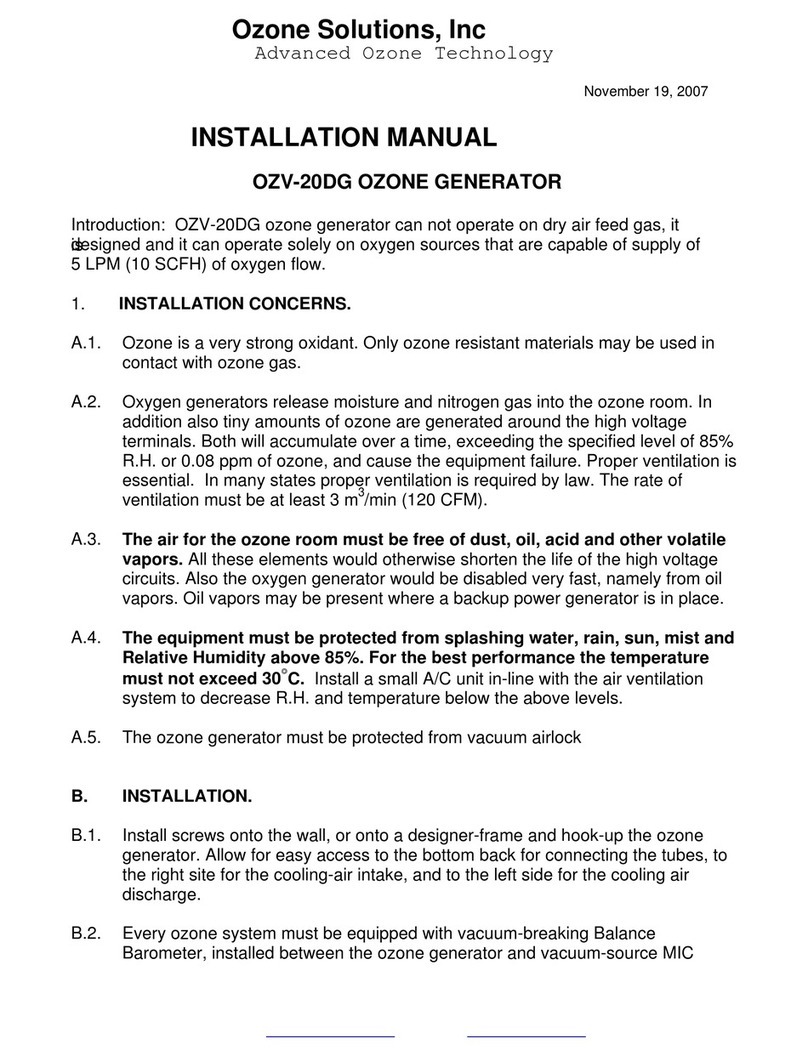
Ozone Solutions
Ozone Solutions OZV-20DG installation manual
